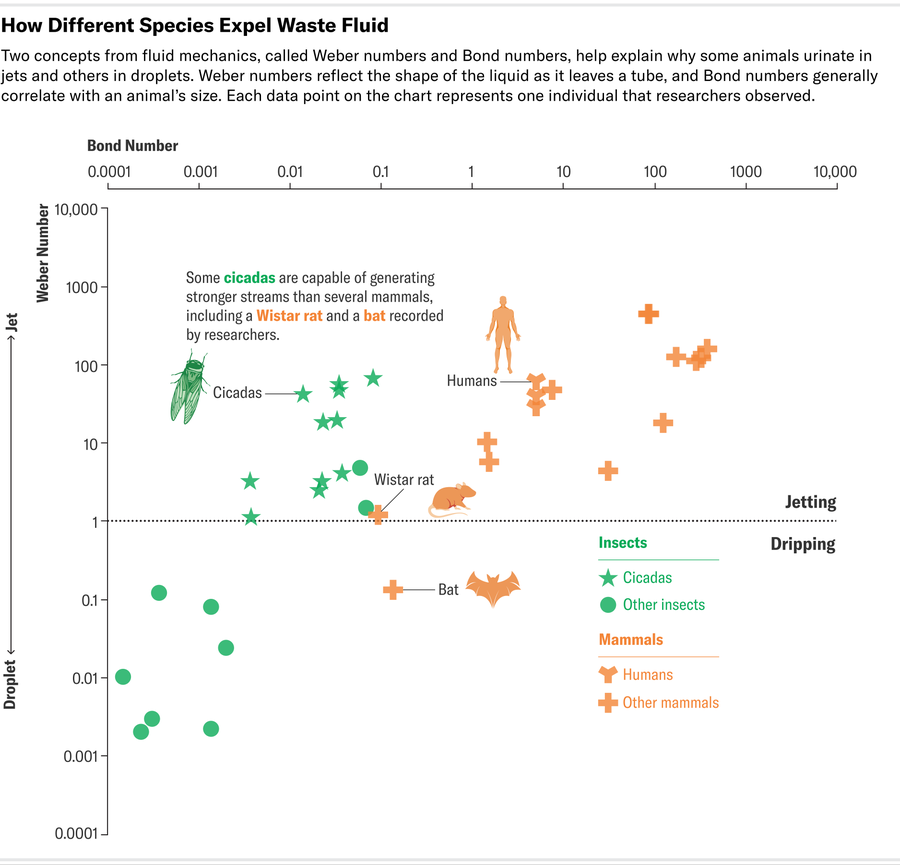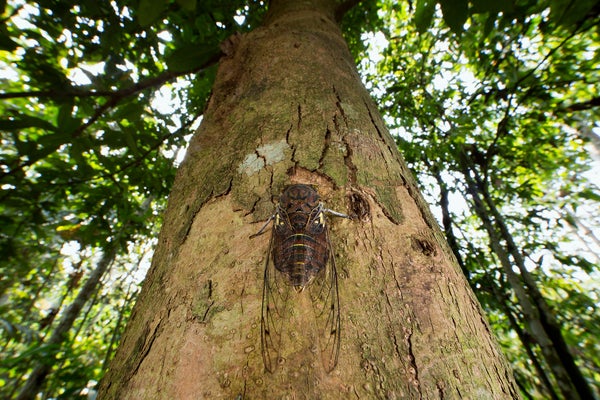As trillions of periodical cicadas emerge across the Midwestern and southern U. S. later this spring, they will generate plenty of buzz—each cicada can generate a sound as loud as a chainsaw. These red-eyed insects will also produce a prodigious amount of pee.
Cicadas consume copious amounts of watery plant fluid, which means that nature is constantly calling. But unlike most insects that flick away waste one droplet at a time, cicadas spray their pee out in high-speed streams reminiscent of the bathroom habits of mammals. According to a new paper published last week in the journal Proceedings of the National Academy of Sciences USA, cicadas are able to pee well above their weight class and produce stronger streams than many mammals.
“In biology there are always exceptions, and the exception here is cicadas,” says lead study author Elio Challita, a postdoctoral researcher at Harvard University, who studies the fluid dynamics of invertebrates. “Instead of peeing in droplets, cicadas are some of the smallest insects that can generate these powerful jets.”
On supporting science journalism
If you're enjoying this article, consider supporting our award-winning journalism by subscribing. By purchasing a subscription you are helping to ensure the future of impactful stories about the discoveries and ideas shaping our world today.
The drone of cicadas might seem inescapable, but observing the arboreal insects relieving themselves takes luck. Challita and his co-author Saad Bhamla, a biomolecular engineer at the Georgia Institute of Technology, initially had to rely on YouTube videos. But while doing fieldwork in the Peruvian Amazon, they encountered several cicadas peeing from almond trees. They also observed a group of cicadas peeing from trees in Singapore. The researchers captured high-speed videos that they then analyzed in slow motion. The videos revealed that the insects squirted jets of liquid out of their backside for up to half a second at a time.
Cicadas have an insatiable thirst for the liquid flowing through a plant’s xylem system. But most species that slurp up xylem fluid expel their waste in individual droplets. For example, sharpshooter insects utilize superpropulsion to fling these droplets away at extremely high speeds without wasting energy.
But cicadas aren’t your ordinary sap-suckers. They are several times larger than sharpshooters, which means they must consume larger volumes of xylem fluid, which is around 95 percent water. To cobble together enough nutrients, each cicada must consume up to 300 times its body weight in xylem fluid each day—“which means they have to pee a lot,” Challita says.
For cicadas, the researchers suggest that forming a jet of liquid is more energy-efficient than flinging away their copious waste by the droplet. Fortunately, cicadas’ relatively large body size allows them to expel jets without being overpowered by the liquid’s surface tension, which prevents smaller insects such as sharpshooters from starting a stream.The jets can also be a weapon of self-defense: when threatened, cicadas spray intruders with jets of liquid waste.
Cicadas might even relieve themselves in jets before they are fully grown, says Richard Karban, an entomologist at the University of California, Davis, who was not involved in the new study. Young cicada nymphs spend most of their life underground and are known to use their watery waste to wet and then shape the soil around them. They use “these wet clods of dirt” to create their subterranean chambers, he says. “That they’re able to direct the excreted urine makes a lot of sense.”
Cicadas might be heavyweights among sap-sucking insects, but they are pipsqueaks compared with mammals. To determine how cicadas would fare in a peeing contest against much larger animals, the researchers compiled fluid dynamic data for creatures ranging from cicadas—which weigh less than a penny—to elephants.
As the team compared the urinary dynamics of these various species, it paid close attention to the fluid’s Weber number. This number describes the shape of liquid as it exits a tube and accounts for the tube’s diameter and the liquid’s speed, density and surface tension. The higher the speed and bigger the diameter—or the lower the surface tension—the higher the liquid’s Weber number. Typically, any Weber number below one correlates to dripping, while anything above one correlates with jetting. The researchers compared these Weber numbers with another metric in fluid dynamics, the Bond number, which represents the size of the tube and the force of gravity on the liquid. Smaller Bond numbers generally mean more restricted flow. Some very large animals have both high Weber numbers and high Bond numbers, such as elephants, which pee in explosive sheets.

The researchers found that cicadas were among the only insects to sport a Weber number greater than one and were one of the smallest known organisms to produce high-speed jets of liquid (other insects, such as bees and butterflies, are also capable of peeing in jets). This means they are capable of generating stronger streams than several mammals with Weber numbers below one. This included the Wistar rat, a breed of albino laboratory rat that weighs 100 times more than a cicada but is only capable of tinkling in droplets.
The physics of fluid ejections in the living world goes beyond urination. In a recent review preprint, the researchers explored how fluid is ejected by organisms across nature, from venom-spitting cobras and water-blasting whales to spore-spewing fungi. One model, which they refer to as the “law of urination” in mammals, was put forth by another group of researchers in 2014. It posits that mammals weighing more than three kilograms pee in jets for a nearly constant duration of 21 seconds each time they empty their bladder, while animals that weigh less than three kilograms, such as rodents and bats, generate droplets or a weak stream of pee instead. Cicadas and some other arthropods, however, don’t abide by this law of urination and can pee in a high-powered jet even though they’re pint-sized critters. Understanding how various animals expel fluid may eventually help researchers fine-tune jets and tiny nozzles in technology such as soft robotics.
While little is known about how cicadas’ mini jet streams of pee impact the environment, Karban thinks it is safe to say that these insects will have an outsized ecological impact as they slurp up xylem across the southern and Midwestern U.S. later this spring. “Cicadas are really big players in these forests as a major group of herbivores,” he says. “We’re only aware of them once every 13 or 17 years, but they don’t go away.”
All this xylem has to go somewhere, so it may be best to have an umbrella handy.
